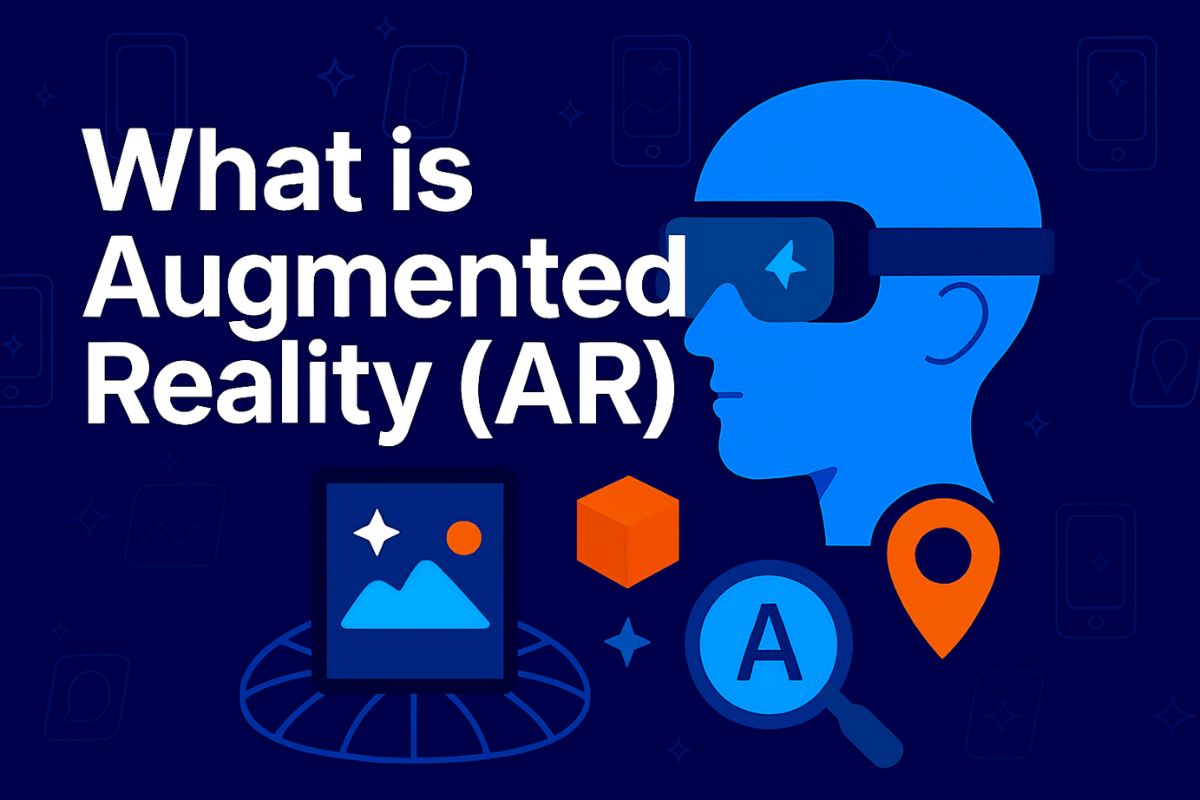Augmented Reality (AR) enhances the real world by overlaying digital images and information using devices like smartphones, tablets, and smart glasses. From gaming and retail to healthcare and education, AR is transforming industries worldwide, including India. This guide covers AR’s workings, applications, benefits, challenges, career paths, and learning resources for 2025.
Imagine pointing your phone camera at a room and seeing how a sofa would look before buying it or using glasses that display navigation directions as you walk. This is the magic of Augmented Reality (AR)—a technology that blends digital content with our real environment.
AR is rapidly gaining popularity globally and in India, revolutionizing how we interact with information, learn new skills, and experience entertainment. Whether you’re a student curious about future tech, a professional exploring new tools, or a business owner looking for innovative marketing ideas, understanding AR is essential.
How Does Augmented Reality Work?
At its core, AR adds computer-generated content—such as images, videos, or 3D models—to the real world in real time.
Key Components of AR
- Camera and Sensors: Capture the user’s environment and movements.
- Processing: A device’s CPU/GPU processes sensor data to determine the position and orientation.
- Projection: Digital content is rendered and overlaid onto the physical world.
- Display: This can be a smartphone screen, tablet, or special AR glasses/headsets.
- Input: Users interact through gestures, voice, or touch.
For example, an AR app on your phone uses the camera to recognize a room, then overlays virtual furniture that fits perfectly into the space.
AR vs VR: Key Differences
| Feature | Augmented Reality (AR) | Virtual Reality (VR) |
|---|---|---|
| Immersion Level | Partial – blends digital content with reality | Full – creates a completely virtual world |
| Hardware | Smartphones, tablets, smart glasses | VR headsets (Oculus, Vive), gloves |
| User Interaction | Interacts with both real and virtual objects | Interacts only in the virtual environment |
| Use Cases | Retail, education, healthcare, navigation | Gaming, simulation training, virtual tours |
While VR immerses you fully in a virtual space, AR enhances your existing environment by adding digital layers.
Applications of Augmented Reality
Global Use Cases
- Gaming: Pokémon Go brought AR to millions by letting players catch virtual creatures in real locations.
- Retail: Brands offer virtual try-ons for clothes, glasses, or makeup. IKEA’s app lets you place furniture in your room virtually.
- Education: Interactive anatomy apps allow students to explore 3D models of the human body.
- Healthcare: Surgeons use AR to overlay vital data during operations for increased precision.
India-Specific Use Cases
| Sector | Example & Description |
|---|---|
| Education | Apps like Diksha and BYJU’S use AR for interactive lessons and visual learning aids. |
| Real Estate | Developers provide virtual walkthroughs to buyers, making property visits easy and immersive. |
| E-commerce | Companies use AR for virtual product demos, reducing returns and increasing customer satisfaction. |
| Tourism | AR-powered museum guides and heritage site tours bring history to life with digital storytelling. |
Benefits of Augmented Reality
- Enhanced Engagement: AR captivates users by making experiences interactive and immersive.
- Real-Time Information: Immediate overlay of useful data improves decision-making and learning.
- Improved Training: Practical simulations in medicine, engineering, and more.
- Boosted Marketing: Innovative AR ads and campaigns create memorable brand experiences.
- Accessibility: AR apps can run on existing smartphones, lowering barriers to adoption.
Challenges of Augmented Reality
| Challenge | Description |
|---|---|
| Hardware Costs | High-quality AR glasses and headsets can be expensive and bulky. |
| Privacy & Security | Collecting and processing location and user data raises privacy concerns. |
| Battery Life | Continuous use of cameras and sensors drains device batteries quickly. |
| Content Creation | Developing AR experiences requires specialized skills and tools, increasing costs and complexity. |
| Connectivity | AR experiences relying on cloud processing need reliable and fast internet, which may be lacking. |
Top AR Devices and Platforms (2025)
| Device/Platform | Type | Key Features | Price Range (USD) | Popularity |
|---|---|---|---|---|
| Microsoft HoloLens 2 | AR Headset | Hand gestures, spatial mapping | $3,500 | Enterprise |
| Magic Leap 2 | AR Headset | Lightweight, advanced optics | $3,300 | Mixed reality pros |
| Apple ARKit | SDK/Platform | iOS AR app development | Free | Mobile developers |
| Google ARCore | SDK/Platform | Android AR app development | Free | Mobile developers |
Career Opportunities in Augmented Reality
Popular Roles
- AR Developer: Build AR apps and experiences using Unity, Unreal Engine, and AR SDKs.
- 3D Artist/Designer: Create digital assets and animations for AR content.
- UX/UI Designer: Design user-friendly interfaces for AR applications.
- AR Content Creator: Develop interactive storytelling and marketing content.
- Product Manager: Oversee AR product development and launch strategies.
Salary Insights
| Role | Avg Salary in India (₹/year) | Avg Salary Globally (USD/year) |
|---|---|---|
| AR Developer | ₹6–12 LPA | $80K–120K |
| 3D Artist | ₹4–8 LPA | $50K–90K |
| UX/UI Designer | ₹5–10 LPA | $70K–110K |
| Product Manager | ₹10–18 LPA | $100K–150K |
How to Learn Augmented Reality
Recommended Skills
- Programming: C#, JavaScript, Python
- Platforms: Unity3D, Unreal Engine, ARKit, ARCore
- 3D Modeling: Blender, Maya, 3ds Max
- Understanding of computer vision and spatial computing basics
Learning Resources
- Courses:
- Coursera – Introduction to AR
- Udemy – Complete AR Development Guide
- edX – AR for Everyone
- Hands-on Practice:
- Build simple AR apps with Unity and Vuforia
- Use ARKit (iOS) or ARCore (Android) for mobile development
- Participate in AR hackathons and developer communities
FAQs
1. What is Augmented Reality (AR)?
AR is a technology that overlays digital content like images and 3D models onto the real world via devices such as smartphones or AR glasses.
2. How is AR different from Virtual Reality (VR)?
AR enhances the real environment with digital elements, while VR creates a fully immersive virtual world.
3. What devices support AR?
Smartphones, tablets, smart glasses (like HoloLens), and AR headsets.
4. Is AR used in Indian education?
Yes, many Indian educational apps and institutions are incorporating AR for interactive learning.
5. What skills do I need for a career in AR?
Programming (C#, JavaScript), 3D design, experience with Unity or Unreal Engine, and understanding of spatial computing.
6. Are there privacy concerns with AR?
Yes, AR apps often use cameras and sensors that collect data, raising privacy and security concerns.
7. What is the future of AR technology?
AR is expected to grow rapidly, with applications expanding into healthcare, retail, manufacturing, and smart cities.


